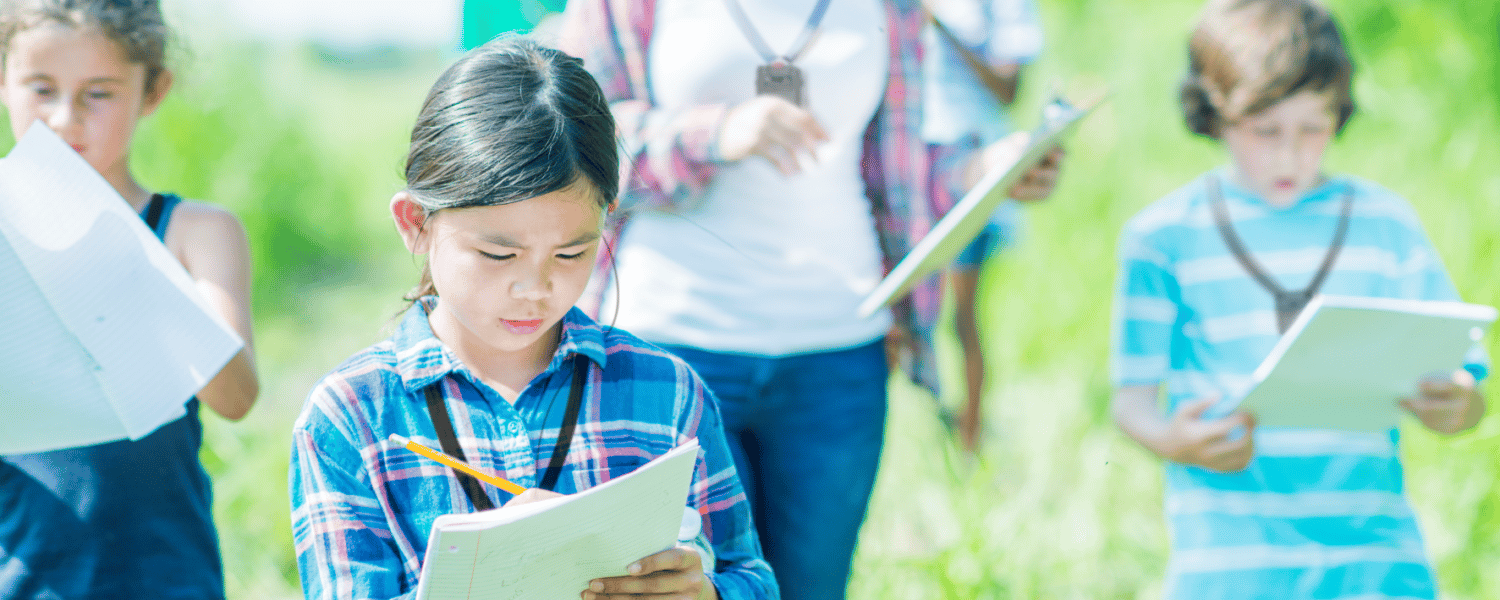By Sam Nord
Sometimes a change of scenery really does make a positive difference.
During the pandemic, many schools moved lunch periods, classes, and meetings outdoors to provide better ventilation and more space for teachers and students to gather. While administrators’ primary intentions in moving events outside may have been to keep people physically healthy and safe at school, they likely helped students academically and supported their mental health, too.
Teachers have reported better behavior and fewer disciplinary actions when students are learning outside. Students who learn outside are often calmer and better able to focus. Other research suggests high school students who learn outdoors are better able to retain what they learn.
Whether a school decides to move learning outdoors occasionally or permanently, meet in a park or a parking lot, it should ensure outdoor “classrooms” are fully accessible for students and teachers with hearing loss.
Audio Challenges in Outdoor Spaces
Outdoor learning spaces present unique audio challenges that can make it difficult for people to hear. There may be loud or distracting background noise, such as nearby traffic, landscape equipment, side conversations, or even birds chirping. In truly open spaces, there are no walls, ceilings, or other physical boundaries to contain sound.
Distance from the audio source and limited or no access to electricity also are challenges to clear communication in an outdoor space. Additionally, there may be noise regulations from nearby businesses or residential neighborhoods.
Assistive listening technology is available to help overcome each of these issues. It can help make outdoor learning accessible to students and educators with hearing loss, as well as those who might occasionally find it difficult to hear clearly in challenging audio environments.
Consider two highly effective assistive listening technologies that are practical for outdoor learning.
Audio Over Wi-Fi Assistive Listening Technology
Audio over Wi-Fi assistive listening technology lets students use their smartphones as receivers for live and recorded school audio. Imagine a teacher wearing a wireless microphone as he leads a science lab in a school’s courtyard or nearby open space.
Students download a free audio over Wi-Fi app on their smartphone or tablet, select the channel featuring the teacher’s mic, and hear audio clearly through earbuds connected to their smart device. Sound also can be streamed from smartphones to portable Bluetooth-enabled speakers and Bluetooth-enabled hearing aids.
All students, regardless of whether they have hearing loss, can hear the teacher despite distance and ambient noise. The teacher does not need to shout or use a loudspeaker, so he avoids vocal strain and does not disturb nearby classes or residences and businesses adjacent to school.
Users can access audio anywhere within the parameters of the school’s wireless network so learning continues as students and teachers seamlessly move from one space to another – perhaps from the lunch tables to a sports field, parking lot, or co-located sanctuary.
Audio over Wi-Fi systems are ideally suited for middle and high school ed environments where many students may already have a smartphone or smart device and are comfortable using mobile technology.
Schools can purchase dedicated audio over Wi-Fi receivers (they do not offer Internet access or text/call functionality) to loan students who do not have, or prefer not to use, their personal smart device for assistive listening. When schools provide signage and neck loops, dedicated audio over Wi-Fi receivers are fully ADA (Americans with Disabilities Act) compliant.
Wi-Fi-based assistive listening systems are easy to install and operate on a school’s existing wireless network. Systems can be up and running in minutes with extremely low latency. The app that users download to access the assistive listening system on their devices can be customized to include messages from the teacher and links to class materials and supplemental information.
Teachers can even create password-protected audio channels, which could be useful for study groups, testing, and in mixed-level classes where students need to access audio content specific to their level.
Mobile Two-Way Communication Technology
Mobile two-way communication systems are another assistive listening technology option for outdoor learning environments that are ideal for all education levels (K-12+). These systems rely on Digitally Enhanced Communication Technology (DECT), a specific radio frequency technology, that enables simultaneous two-way communication.
With this technology, students and educators wear a small, lightweight transceiver (combined audio transmitter and receiver) and earbuds or headphones to communicate. Devices can be quickly grouped to a “leader” device by class, instructor, period, etc. in a storage tray or by tapping units together. To speak, users push and hold a talk button on the device. Others in the group can hear the speaker clearly despite background noise, distance, face coverings, or hearing loss.
Teachers can select one- or two-way communication for their classes, depending on their needs. With one-way communication, the teacher speaks, and all students can hear. Instances where this would be helpful include coaching a sport, directing students on stage, or proxying an exam. With two-way communication, students can use the push-to-talk button on their device to speak to the teacher or the whole class. Applications include class discussions, field trips (on campus or away), and one-on-one tutoring.
Mobile two-way communication systems do not require installation. The devices can be transported, charged, and used anywhere – inside and outside – to deliver clear audio. Speakers do not need to shout to be heard; similarly, students can hear speakers when they whisper in quiet environments like houses of worship or theaters. Up to 20 different groups can use devices simultaneously without interference. Devices are wireless and hands-free so students can easily move about a space and take notes.
Accessibility Everywhere: Here to Stay
Routinely gathering outdoors for structured learning may wane in popularity as temperatures climb very high or drop precipitously, and as communal health risks decrease, but it is not likely to cease entirely. There are too many advantages of learning outside the traditional classroom – from improvements in physical and mental health to capacity and logistics – to forgo this option.
Assistive listening technology ensures inclusion and access to clear sound in any learning environment.
Sam Nord is vice president of global sales at Listen Technologies, a leading provider of advanced wireless listening solutions for 24 years, www.listentech.com.









